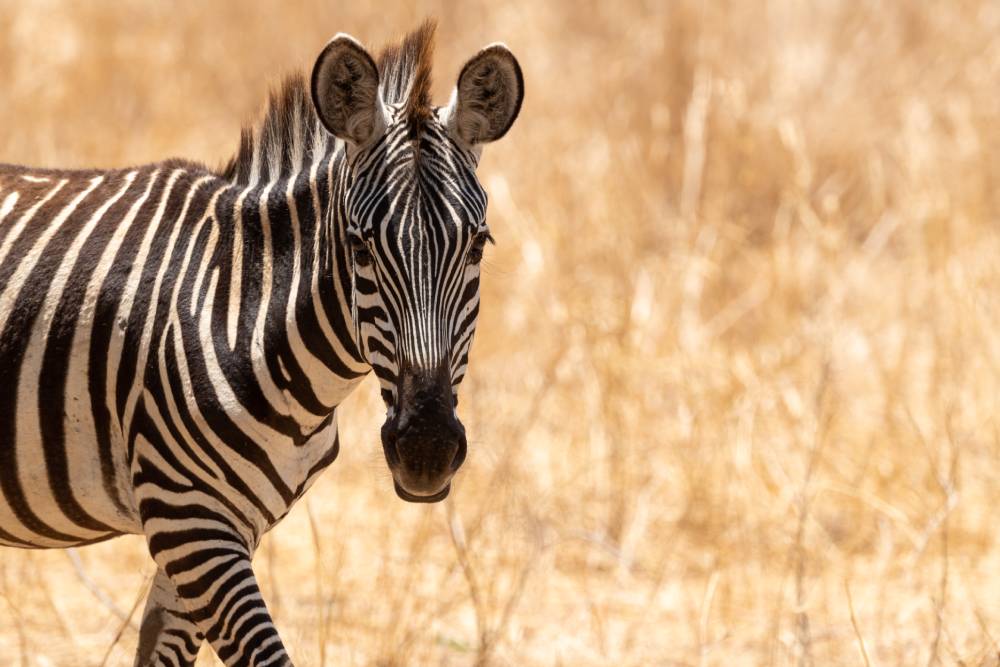Their Ears Have a Language of Their Own, and Other Facts About Zebras
Michelle Milliken
The month of January begins with New Year’s Day and ends with another important date, even if it may not come with its own countdown. International Zebra Day is held on January 31 every year. The event aims to bring awareness to the importance of protecting these great animals, which consist of three species: the Grevy’s zebra, the mountain zebra, and the plains zebra. You can mark the occasion by learning a few new things about these striped marvels.
There Are Several Theories As to Why They Have Stripes
When we think of zebras, their stripes are likely one of the first things that come to mind, but why do they have them? That’s up for debate. It was long thought that they could help confuse predators who were looking for a nice zebra lunch, though that theory has been called into doubt with some recent research. Other studies have indicated the stripes may help repel biting flies. Thermoregulation is a theory, as well.
They’re Dark-Skinned and Have Black Fur with White Stripes
The next thing people may consider when it comes to the stripes is whether the animals are white with black stripes or black with white stripes. It’s the latter, not the former. First off, zebras have dark skin underneath those stripes. Secondly, the stripes exist due to skin cells called melanocytes which transfer melanin into the animal’s fur. The fur that gets the melanin is black, while the fur that is denied the melanin is white. Britannica says that because the white stripes only occur due to a lack of melanin, the animal’s default color is black.
They Bark
You may get a little alarmed when a strange dog barks at you. It may be even more concerning if a zebra does. Yes, zebras bark. This happens when they’re trying to get the attention of the herd, like letting them know that there’s a danger present. That’s not their only form of vocal communication, though. They also bray like donkeys. Apparently zebras are the multi-linguists of the animal world.
Their Ears Speak Their Own Language, Too
Zebras don’t just communicate vocally. They also use their ears. The position of their ears can give other animals an idea of how they’re feeling. If their ears are back, it means they’re pretty upset, especially if their bared teeth make an appearance. Ears pricked up and pointing forward, though, demonstrate alertness. They’re paying attention to something.
They Protect the Vulnerable When Predators Attack
Zebras deal with a variety of predators, including lions, hyenas, and cheetahs. When one attacks, though, these animals have each other’s backs. Predators are apt to go for the weakest link, like the young or the aging. To protect these members of the herd, as well as any that may have been wounded, zebras will form a circle around them to keep the predators from picking them off. They can also put up quite a fight, with strong kicks and butts.
Someone in the Herd is Always Awake
Zebras can double as night watchmen. Well, some of them anyway. At any given point, some members of the herd are always awake to keep an eye out for trouble. This allows everyone to take a snooze with someone on guard.
Foals Get to Walking Quickly
Human babies are wobbly at best even at a year old. Not so for zebra babies. After a gestation period of around a year, a foal is born generally weighing somewhere between 60 to 80 pounds. It’s also born ready to take on the world. Within an hour, it can run. If it runs too far, though, it will be able to find its mom through the patterns on her rump and tail, as well as her vocalizations and scent.
They’re Pretty Speedy
Once that foal gets her legs and gets to growing, she’ll be ready to complete with some Olympic sprinters… or to wipe the floor with them. Zebras can top out at speeds around 40 miles per hour. That’s way past sprinting great Usain Bolt’s top speed of just shy of 28 miles per hour. Don’t invite them to a friendly race.
A Group of Zebras is Called a Dazzle
There are some interesting names for groups of animals. A bunch of owls together is called a parliament, though it’s unclear if they create any laws. Put a bunch of lemurs together, and they’re a conspiracy. A group of zebras? They’re a dazzle. How fabulous.
They Face Threats
These swift, dazzling, and barking animals unfortunately face threats, from habitat loss and hunting for their skins to competition from livestock and other agricultural concerns. Grevy’s zebras are faring the worst, with fewer than 2,500 still in the wild. They’re listed as endangered on the IUCN Red List. Meanwhile, the mountain zebra is listed as vulnerable, and the plains zebra is near threatened.
If you'd like to do your part to help vulnerable species, click here.
Michelle has a journalism degree and has spent more than seven years working in broadcast news. She's also been known to write some silly stuff for humor websites. When she's not writing, she's probably getting lost in nature, with a fully-stocked backpack, of course.






























